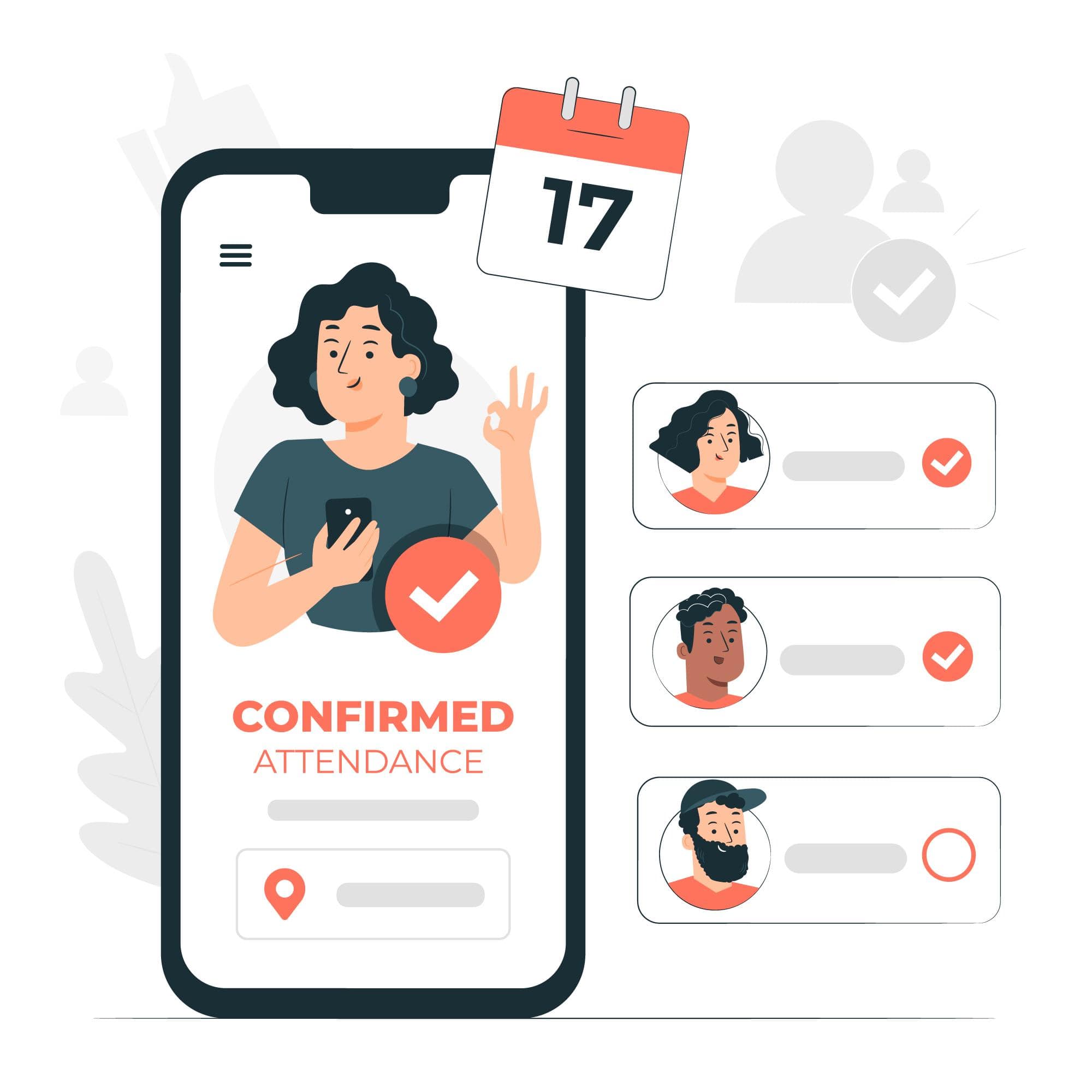How to Write a Webinar Script: A 9-Step Guide To Creating High Conversion Webinars
Hosting a webinar is a great way to generate leads Over the past two years, the use of webinars as an acquisition channel grew by over 300%.
Hosting a webinar without experience may seem daunting, but all it takes is enough planning, the right tools, and a few helpful tips for writing your webinar script.
If you’re new to the webinar world and want to impress those leads, you’re in the right place. This guide to writing a webinar script and outline of a webinar template will get you hosting webinars that convert in no time.
Keep reading to find out everything you need to know about how to write a webinar script that will engage your audience and turn them into loyal brand advocates.
What is a webinar script?
A webinar script is a plan for what you will say in your webinar. At a minimum, a webinar script includes an intro, points of discussion, and a call to action.
When writing a webinar script, you can write out your entire dialogue word for word or put down bullet points of the key topics you will cover. Your webinar script can also include timings, so you stick within your time limit during the presentation.
If you’re interviewing a guest for your webinar, include all the questions you want to ask, along with how much time you want to give them to answer. Another practical element to include in your script is how the dialogue syncs with your webinar presentation on screen.
The importance of webinar scripts
Presenting a webinar without a script is like showing up to give a speech without any preparation. It’s impossible to present an entire webinar ad hoc if you want to maximize audience engagement.
Even if you’re a seasoned expert in the webinar topic you’re presenting, you need a plan for how you will demonstrate your knowledge and a goal for your webinar. Your webinar goal will help you decide how you present the information in the webinar, and a good webinar script will help you avoid going off-topic. It will also help you keep your train of thought, making it easier for your audience to follow.
The overarching goal of any webinar should be to provide as much value as possible for your target audience. Using a webinar script outline keeps all your info organized and ensures everything you present to your audience is actionable. You set yourself up for success when you plan these actions.
Suppose more than one person is participating in the webinar. In that case, it’s even more important to have a script and webinar agenda so the conversation flows and provides value to the audience.
Writing your webinar script in advance will also help you narrow down the niche you want to discuss in your webinar. Thinking about the exact structure of your webinar can help you take a broad topic, narrow it down and turn it into educational content, which will be beneficial for your audience.
How to write a webinar script
1. Decide on your topic

Before you write your webinar script, you need to determine what you will talk about. Ask yourself these questions:
- How can you educate your audience in a way that will convince them they need to become your customer?
- How can your webinar provide solutions?
Think about your customer’s pain points and how your product or service solves them. If you’re unsure about the topic for your webinar, ask your existing audience. You could post a poll on social media or send a survey to your email list. That way, you’ll be sure you’re creating content your audience wants.
Another way to help you decide on your webinar talking points is to A/B test some webinar titles via social media ads. See which title gets the most traction, and then go and create the content. That way, you’ll know you’re creating something which will convert to sign-ups.
If you spend hours writing the webinar script and pre-recording it without knowing if your audience is interested in that topic, your webinar could flop. Do you want to waste time and resources creating a webinar nobody wants to watch?
Another question to ask yourself is:
What key takeaways do you want your audience to get from your webinar content?
Once you know the answer, work backward to determine how you’ll provide those takeaways.
For example, you want to talk about lead generation in your webinar. That’s a broad topic, so you could narrow it down to lead generation from your email list. Next, you’ll want to consider a few strategies for generating leads from email marketing that your webinar audience can implement. You’ll make this broad topic into bite-sized, actionable tips.
2. Decide who the host will be
Once you’ve settled on a topic, it’s time to figure out who the best person is to host a webinar on this topic. If you’re a solopreneur, chances are you’ll be the host. But, if you have a team, there might be someone who is best equipped to host this webinar, whilst they might not be the best presenter for a webinar about another topic.
Aside from choosing the best fit for the webinar, you want to choose a presenter who knows how to grab the audience’s attention, isn’t shy on screen, and can make any topic come across as enjoyable. Ideally, they have some experience in public speaking as this will help them engage the watchers.
Your choice of presenter is crucial for your overall webinar engagement rate and the probability that your audience will take the call to action. Once you decide who will deliver the webinar, it will help you write the script with that person in mind.
3. Determine your webinar format
The next step in writing a solid webinar script is deciding on the webinar’s structure. Here are a few different ways to format your webinar:
- Interview an expert, or host a guest speaker.
- Share a presentation.
- Host an interactive webinar with lots of opportunities for audience engagement.
Which one of these is the best fit for your webinar will depend on your topic, your audience, as well as whether you’re planning to host the webinar live or whether you’ll record it to be watched on-demand (or both).
Here are some ideas and examples for structuring your webinar topic:
- Going into detail on an FAQ you regularly receive from clients
- Inviting guest speakers on to talk about a niche in your industry. Have a look at this example from We Work Remotely:
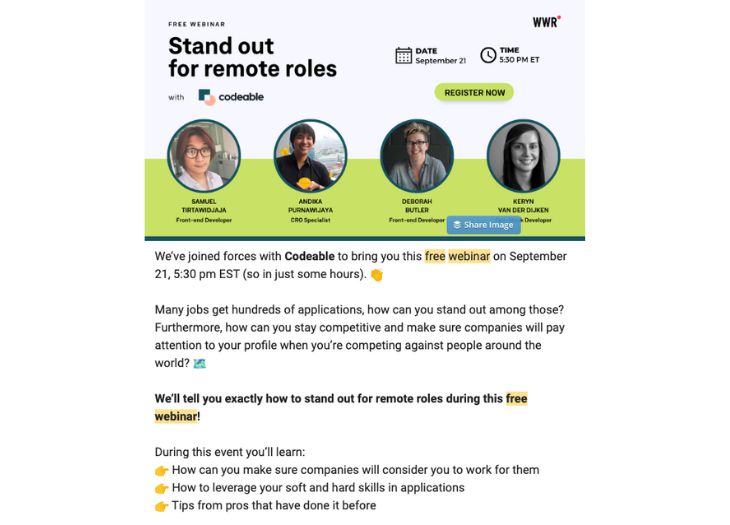
- A ‘how-to’ webinar that shows your audience how to master a specific set of skills, such as this webinar from money mindset coach Nikki Bartol:
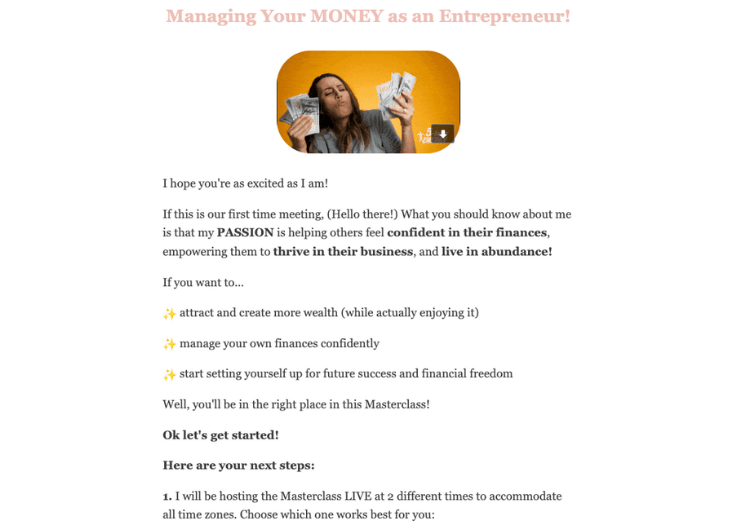
- Share a process you’ve used to gain success in your business as we did in this one:

- A walkthrough demo of how a new feature of your product works, like Planoly did here:
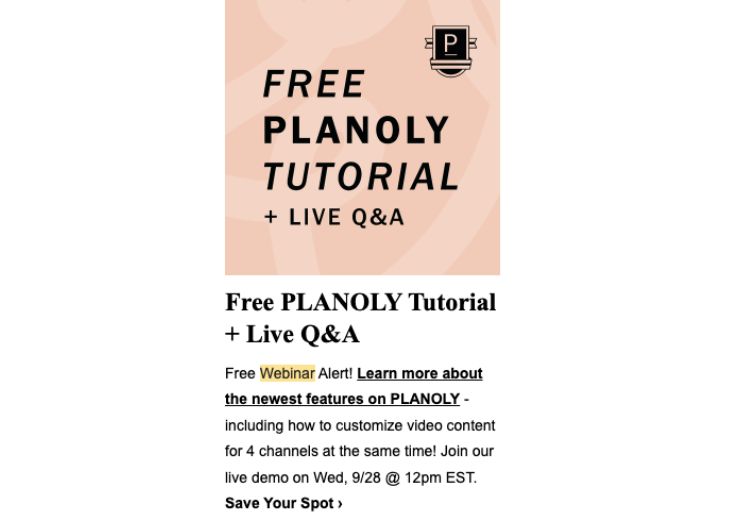
As you’re thinking about you’re webinar structure, you also need to decide how long your webinar we’ll be. A few considerations go into that, which we talk about in this post.
4. Create a strong webinar introduction
The webinar introduction script is what will let you seize the opportunity to capture your audience’s attention. If you bore them in the first few minutes, you’ll surely lose them. Remember that only 34% of webinar attendees stay until the end.
Here are some points to keep in mind for your webinar intro script:
- How will your webinar host(s) introduce themselves? Let them share who they are and why they are experts in this topic. Have them mention awards, achievements, and anything else that gives them credibility and authority on the subject.
- What are the key takeaways from this webinar? Why should the audience stick around and give you an hour of their time?
- Be clear about the value the webinar will add to the audiences’ lives.
- Emphasize the pain point you know your audience faces and tell them how your webinar will help them with the solution.
- Offer hooks that will keep the audience wanting more as you share some of the questions you will answer.
Try to keep your intro evergreen, which means you don’t mention dates or current affairs. That way, you can reuse the content and make the webinar on demand in the future. Learn more about setting up an evergreen webinar funnel here.
5. Make use of storytelling and open loops
Storytelling
Listeners engage with stories; storytelling is a great way to teach, inspire, and connect with your audience. Research shows that people are 20 times more likely to remember a piece of information if they hear it in a story.
To keep people engaged in your webinar, master the art of storytelling. If you’re stuck for inspiration, tell personal stories about your journey in business. How did you get to where you are, and what challenges did you face growing your business? People want to hear about your failures and successes because it shows you’re human.
Open loops
If you want to successfully deliver a webinar that keeps the same number of attendees engaged from start to finish, you don’t want to share all your best tips at the beginning. Keep this in mind when developing the structure of your webinar script. As part of your compelling storytelling, you use open loops.
Open loops are a well-known strategy used in content marketing. You use them by teasing bits of information that you’ll share later. This creates excitement and anticipation, similar to how TV shows leave you wanting more after each episode. Keep your audience engaged by mentioning what will come next. They’ll naturally be curious about the answers and stay to find them out.
Open loops are a great way to help the presentation flow and connect different sections of the script. You could use language such as “we’ll get to this in more detail later” when introducing a concept. Keep in mind that you need to deliver on those promises, if you use open loops that you never close, you could end up frustrating your audience.
6. Break your content into manageable sections
If your topic is complex, divide it into digestible sections of content. When writing your webinar script, think of how you’ll illustrate your key ideas visually. You don’t need to share your entire presentation with your attendees, but a few slides will help drive your key points home and stick in the minds of your audience.
When writing webinar scripts, think about your language and how you want your presenter to come across. Do you want a more conversational tone that makes the audience members feel at ease? Or does a more formal, corporate tone suit your content?
To make your content accessible to a global audience, keep the language clear and concise, and try to avoid slang, colloquialisms, and industry jargon. Using language your audience doesn’t understand may cause them to get bored or feel frustrated and switch off.
If you want to get people excited about your business and the services you can offer them, you want to deliver your content in a fun, exciting, and relatable way. Storytelling and providing solid examples from innovative companies are great ways to capture attention.
7. Provide actionable examples
Explaining the theory behind your webinar topic is a good idea, but if you don’t have examples to back up your points, your audience won’t get as much value from your webinar as they could.
When writing your webinar script, include examples of how you’ve put your knowledge into action. Show examples of when you’ve used the strategies you’re teaching for a client and prove the success the client had as a result.
Sharing examples will not only prove your success and authority on the topic but will give your audience actionable takeaways. They will learn how to implement these ideas in their business, which will provide much more value than listening to a lecture.
Say, for example, you were presenting a webinar about lead magnets. You could share a graph like this that shows the CR growth rate on lead magnets over a certain period:
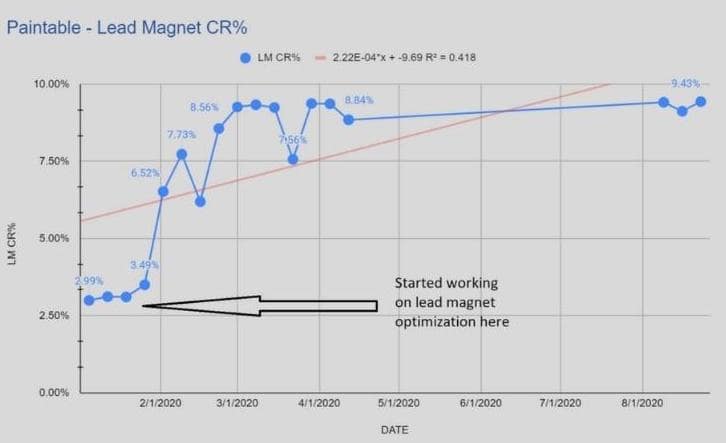
Sharing examples shows you have proven success in the topic, you can then explain the exact steps you took to achieve this success. Learn more about how we grew the lead magnet opt-ins for the above client here.
8. Include time for a Q&A
If you present your content for over an hour, your audience likely has some questions. Leave the last section of your script open for audience questions. You’ll increase potential customer engagement, answer some FAQs, and have an opportunity to convince your attendees even further that you can help them solve their problems.
While you can’t prepare for what your audience asks, you can jot down some bullet points in your script for answers to commonly asked questions.
9. How to close a webinar: Don’t forget the CTA
A strong call to action is one of the most important things to consider when writing your webinar script. What do you want your audience to take? How will you share this with your audience and persuade them to take the next steps?
The end of your webinar is also an opportunity to say thanks for your audience’s time and tell them where they can find more of your services. If someone stays until the end of your webinar, they are a very strong lead, so use this opportunity effectively.
Make your CTA simple to perform so you don’t scare the lead away. Here are some ideas for CTA to include at the end of your webinar:
- Sign up for one of your online courses
- Make use of a limited-time discount
- Book a call with your sales team
- Purchase from your website
- Connect with you on LinkedIn
Lastly, offer a few closing comments and information on your next webinar, if it’s part of a series, before saying bye.
10. Review your webinar script

Once you finalize your script, review it with other team members. They will be able to give you a few tips on how to improve it and assess whether or not you effectively covered the main points.
You should also remember that your script is there as a guide to keep you on track during the live webinar. Try to memorize as much content as possible beforehand, a presenter reading word for word from their script won’t make a compelling webinar.
Free webinar outline template
Flesh out this webinar script template to help you create your next webinar:
A good introduction includes:
- An introduction of the host, guest, and/or webinar presenters if there are multiple speakers.
- Info on what the webinar is about.
- What the audience will learn.
- How attendees will be able to apply those learnings.
Present the problem:
Your research and understanding of your customer will help you outline the problem your audience faces, so:
- Reiterate the pain point.
- Share why so many businesses fail in this area (e.g., lead generation).
- Share your personal experiences with the problem (how many strategies you tried before you found an effective one).
- Relate to your audience and show them why this is their problem.
- Demonstrate that you have proven techniques that help solve this problem.
Provide the solution
- Tell them how to solve the problem.
- Share evidence, examples, and success stories.
- Explain how attendees can apply the solution to their own situation.
Offer Q&As
- Include some answers to common FAQs in your webinar script, so you don’t get caught out in this section.
- Prepare to ask for feedback if not many questions come in.
CTA
- What do you want your audience to do next?
- Tell them how to do it.
Start making sales with webinars
Now you know how to write a webinar script, you can start hosting webinars that impress your audience and compel them to action.
While there’s no perfect webinar script template, you can use the webinar script template above to get started, and you’ll be ready for your first live event in no time.
Do you need help with generating leads for your webinar? Get in touch, and we’ll build you a webinar funnel that converts.




